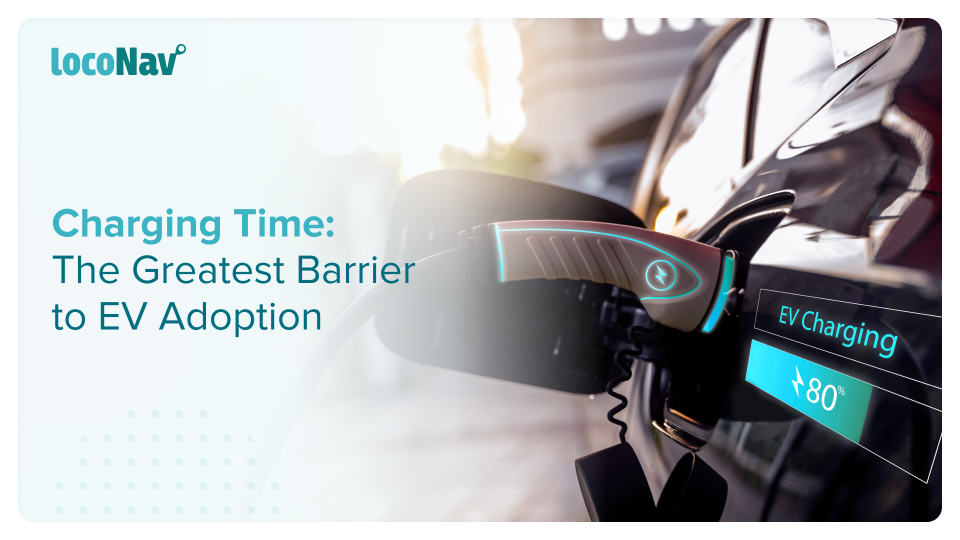

Have you ever been out of the home and discovered that your phone battery was running low and there was no charger nearby? If you are an EV driver or operate an EV fleet, you have probably felt something similar to this: the sinking sense that you’re about to run out of energy in your car.
Fleet Managers and Drivers need to be assured their vehicles will always arrive at their destination safely and on schedule. Although the global usage of electric vehicles is expanding at a rapid pace, one of the major limitations is the electric vehicle charging time.
In this blog, we will discuss the role of electric vehicle charging time in its adoption, factors impacting EV charging time, and tips for increasing Electric Vehicle charging time.
Manage your fleet efficiently with LocoNav’s Fleet Management Solutions!
How Does Charging Time Affect the Market Dominance of Electric Vehicles?
The journey to zero-transmission movement is not without difficulties. From an environmental standpoint, the world cannot move quickly enough to battery-powered transportation. Given the size of our highway system and the number of vehicles on the road, vehicle emissions have a substantial influence on climate change and environmental implications.
Air pollution is at an all-time level, endangering public health. As a result, there is a pressing need to cut emissions in any manner possible, and moving to EVs is a positive move in the right direction. However, numerous obstacles must be solved before EVs become widely used. The market dominance of Electric Vehicles is mainly limited by their Charging Time because high charging times mean:
- That there is little to no scope for charging your vehicle mid-journey.
- In cases of a long journey, when you recharge your vehicle on a highway, you might be left stranded till your vehicle gets charged.
- The vehicle unfit for long journeys
- The vehicle is unfit for carrying perishable goods
- During charging, your commercial vehicle and cargo are left exposed to criminals and theft.
Since the electric vehicle charging time plays such an important role in its adoption and market penetration abilities, we will now discuss the factors that affect electric vehicle charging time and how you can decrease that time.
Factors Impacting Electric Vehicle Charging Time
Every EV is unique, however, the following are the 4 most prevalent factors that influence charging speed:
- Your State of Charge (SoC)
Your State of Charge is how charged your battery is when you start charging. Consider it a fuel gauge. When a battery is practically empty—when it has a low SoC—it charges the fastest.
- Your battery’s temperature
Because high temperatures can shorten a battery’s lifespan, your EV does not want the battery to become too hot or to begin charging too quickly when it is too cold.
- Whether you’re operating your vehicle while charging
If you remain in your car during fast charging, keep in mind that some of the energy intended for your battery is redirected to other loads. When the battery is redirected to in-cab air conditioning or heating, lights, radio, and other accessories, the charging time of an electric car can dramatically rise.
- Battery Health
Even though it takes time, the battery can degrade and lose charge capacity over time. Because each EV is unique, the usual loss of battery capacity should be specified in your vehicle’s warranty. As a general guideline, when rapid charging, it’s best to end the charge with an 80-85% SoC. This will prevent your battery from overheating and provide you with extra free time.
Tips for Decreasing Electric Vehicle Charging Time
Here are 6 top tips for decreasing your electric vehicle charging time:
- Fast charging should be avoided.
- Avoid completely emptying the vehicle’s battery before charging it.
- Reduce the number of batteries at 100% charge.
- When parked, limit your exposure to exceptionally high temperatures.
- Use the correct voltage chargers as directed by your vehicle OEM
- Charge your vehicle using the correct level of charger
Bottom Line
As demand for electric vehicles grows and EVs emerge as reasonable alternatives to ICE vehicles, an ecosystem of businesses must band together to take activities that will enable their widespread usage. Closing the charging gap is one such move that will necessitate a deliberate, joint effort. That is why finding answers to the problems highlighted here should be at the top of the priority list for all stakeholders in the EV ecosystem, especially if recharging access becomes the most significant hurdle to EV uptake.
FAQ
How To Charge Electric Vehicle Faster?
- Choose a vehicle with optimum battery size
- Charge your EV using Level 3 chargers
- Avoid letting your EV get to extreme temperatures
- Avoid draining your battery to 0% before charging
Can I Reduce The Electric Vehicle Charging Time?
Yes, by using the tips highlighted in this blog, you can reduce your EV charging time.
What Is The Optimum Electric Vehicle Charging Time?
Charging an electric vehicle might take as short as 30 minutes or as long as 12 hours. This is determined by the size of the battery and the charging point’s pace. With a 7kW charging point, a typical electric car (60kWh battery) takes little under 8 hours to charge from empty to full.
Does Fast Charge Impact EV Battery Life?
Yes, quick charging will cause long-term damage to electric car batteries and may possibly limit their lifespan.
